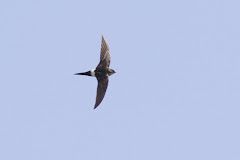During our trip to Morocco we visited a site called Merja Zerga (see previous post) to look for Marsh Owls. It was at this time that I received a text message from a friend saying that a BLACK LARK had been found at my old local patch of Winterton-on-Sea in Norfolk! Now Black Lark is a VERY rare bird in Britain with only two previous records. It was found by local birder, Sean Offord (who apparently had to pick himself up off the dunes after realising what he had found) at about 1600 on Saturday, allowing many local Norfolk birders to see it before dusk. It apparently gave very good views and even song-flighted on two brief occasions during the evening. The bird was an adult male in full spring finery, with all-black body plumage contrasting with the heavy, ivory-coloured bill and the neat white flecking on its mantle and upper scapulars (you can see pictures here - look at the entry for 20 April). There was quite a crowd present at dawn on Sunday morning (much to the surprise of the beach car park attendant!). However, the bird didn't stay long and at around 0700 on Sunday morning it waddled behind a tuft of marram grass on the dunes and, despite not being seen to fly, was never seen again much to the disappointment of the hordes of birders who decided to prioritise breakfast over getting on site at dawn!
To illustrate the excitement caused by this bird, there were apparently birders from Belgium and Spain present on the Sunday morning, who had travelled overnight especially to see this bird! Madness....
Sean's Black Lark represents the third record for Britain, following a male at Spurn Point (East Yorks) on 27th April 1984 and a well twitched male at South Stack RSPB (Anglesey) from 1st-8th June 2003. Black Lark is a largely resident species of the grassy steppes of Central Asia from the Lower Volga region of SE Russia to NE Kazakhstan. Outside the breeding season, nomadic flocks wander widely, occasionally roaming west to the Ukraine.
Sean will now have to complete a description of the bird for the British Birds Rarities Committee and, no doubt, write various articles and conduct interviews about its discovery. Fame at last...
Subscribe to:
Post Comments (Atom)






No comments:
Post a Comment